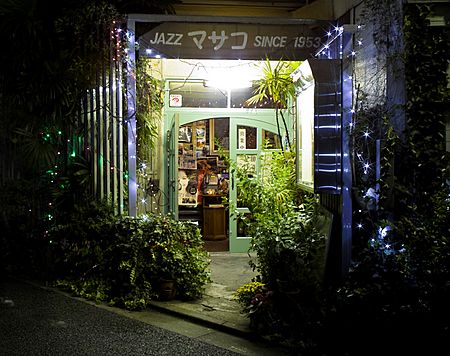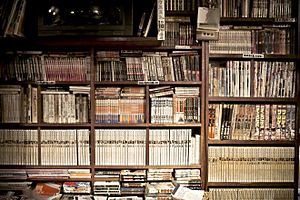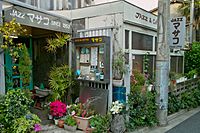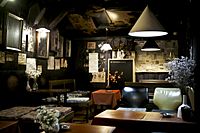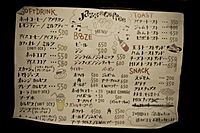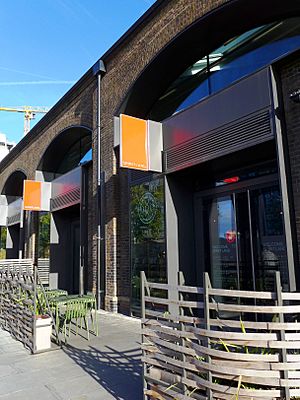Jazz kissa facts for kids
Jazz kissa (Japanese: ジャズ喫茶) are unique cafes in Japan. People go there to listen to recorded jazz music very carefully. Unlike places where music plays in the background, jazz kissa are all about enjoying the music itself.
A typical jazz kissa has a great sound system and a huge collection of music. The lighting is often dim, making it a cozy place to relax. They usually serve coffee and other drinks.
The first cafes playing recorded jazz opened in Japan in the late 1920s. This was when Japanese people were very interested in Western culture and music. Before World War II, there were about 80 jazz kissa. Many of them closed during the war.
After the war, jazz kissa became even more popular. They were important because imported jazz records were very expensive. Most people couldn't afford them. Jazz kissa were places where musicians, writers, and jazz fans could hear the latest music. At their busiest time, there were around 600 jazz kissa all over Japan!
In the 1970s, it became easier and cheaper for people to buy their own music players and jazz records. This changed the role of jazz kissa. Many closed down, and the ones that stayed open were often visited for old times' sake. However, jazz kissa still exist in Japan today, and new ones are even opening! These cafes helped introduce jazz music and modern Western culture to Japan. Their influence has spread, with similar "listening bars" opening in many other countries in recent years.
Contents
History
Early Days Before the War
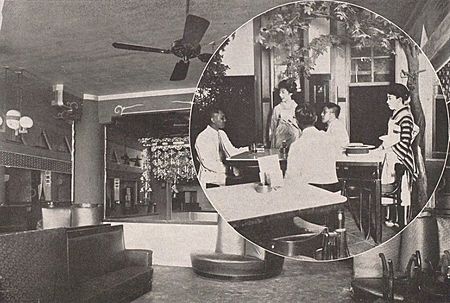
In the 1920s and 1930s, coffee, cafes, and jazz music became very popular in Japan. This was part of a wider interest in Western ideas among the middle class. Many cafes would play music using record players.
The first music cafes, called ongaku kissa, opened in Japan in the late 1920s. Because there were rules about live music, these cafes were some of the only places where people could hear Western music. They had large collections of records, often focusing on certain types of music. They also had modern sound equipment. The cafes often looked fancy, decorated in Western styles.
Cafes playing Classical music were popular, as were those playing jazz and Latin music. These places were often for young people, especially men who couldn't afford to buy records themselves. The staff were usually female waitresses. Often, music lovers ran these cafes, not just business people trying to make money.
It's thought that the first cafe to play only jazz music opened in 1929. These early jazz kissa, with their huge record collections, were very important. They were a key resource for record collectors, musicians, and even jazz writers. Eventually, there were about eighty jazz kissa in Japan, mostly in Tokyo.
However, during World War II, these places had to close. Many jazz kissa lost their record collections in bombings. Most jazz kissa that opened after the war were new and not connected to the old ones.
Coming Back After the War
In Japan in the 1950s, live jazz shows were rare. It was also hard to find jazz records made in Japan. Records had to be brought in from America, and they were extremely expensive. While too costly for most people, jazz kissa could afford them. This meant that jazz kissa, along with radio, were some of the only places to hear the newest jazz music.
Jazz kissa helped teach jazz fans and musicians, like Toshiko Akiyoshi and Sadao Watanabe. The cafe owner would often introduce records in detail before playing them. Some customers would even take notes! A Japanese magazine called Swing Journal even printed introductions for records to be used in jazz kissa.
Unlike the pre-war jazz kissa, these new ones were usually simply decorated. They mostly sold only drinks. By the end of the 1950s, most Japanese cities had jazz kissa. Some jazz kissa would even focus on playing only one specific type of jazz.
It was still hard for people to buy jazz music in the 1960s. This especially affected university students. They loved the cool, artistic vibe of the cafes and made up a big part of the customers. However, more places started having live jazz music. Some jazz kissa in the 1950s had live music, but this became less common in the 1960s.
A new kind of jazz kissa appeared in the mid-1960s. These cafes were known for their dim lighting and very loud music. They often had strict rules, like no talking. This way of enjoying jazz was linked to a style called free jazz and student protests. Jazz kissa even hosted political meetings and talks organized by students. But this trend slowed down by the end of the 1960s.
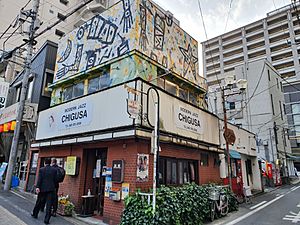
At their peak in the mid-1970s, there were about 600 jazz kissa in Japan. Over the next few decades, changes in society led to fewer jazz kissa. Records and stereo systems became affordable for teenagers and students in the 1970s. Also, live jazz music became much more common in Japan.
A new style called jazz fusion became popular. Jazz kissa had to play this new music, which some older jazz fans didn't like. To keep customers, cafes started playing music at a lower volume and allowed people to talk. They also sold alcohol and made their decor brighter.
In the 1980s, personal music players became even more common. CDs quickly replaced vinyl records. Live jazz was everywhere in Japan, and jazz music often played in the background in restaurants. These changes made it harder for jazz kissa. However, one good thing was that jazz kissa became some of the only places left to hear jazz from original vinyl records. Customers kept visiting them to remember the past or to feel like they were truly experiencing jazz music.
Jazz Kissa Today
Today, there are far fewer jazz kissa than there were in the 20th century. Most of the remaining ones are similar to how they were right after the war. Music is mainly played from vinyl records, covering many types of jazz.
However, new jazz kissa are still opening. These newer cafes try to attract younger customers. They create a more relaxed atmosphere and sometimes have live performances from DJs and musicians.
What They Are Like and How to Act
In jazz kissa, the music is usually chosen from the cafe's large collection. It's played loudly on a very good sound system. High-quality stereo equipment is a main feature, and sometimes the speakers are even custom-made for the room. The music is meant for people to listen to carefully, not as background music or for dancing. Often, one whole side of a record is played before the music is changed.
Jazz kissa typically have dim lighting and old-fashioned furniture. They are often found on quiet side streets. The walls of many jazz kissa are decorated with album covers. There are also shelves filled with vinyl records and CDs. A Japanese musician, Otomo Yoshihide, said that a classic jazz kissa in the 1970s was a small room. It had a counter, hundreds of vinyl records, many magazines, and a pair of huge speakers.
A jazz kissa is run by a "master" (master (マスター, masutā)). This person usually owns the cafe and is the only staff member. The master serves drinks and food to customers. They also choose all the music. The choice of music is completely up to the master. Customers usually don't ask for songs, unless they are regular visitors. Masters are known for knowing a lot about jazz music. People often rely on them to check facts for jazz critics and writers.
Jazz kissa are known for having rules for their customers. Cafes often ask people to listen to the music quietly. They are not places for loud talking or socializing. Coffee and other drinks are served. Drinks often cost more than in other places. This helps the cafe make enough money from a small number of customers. Customers can stay as long as they like. People usually visit alone or with one other person, never in large groups.
Impact
Jazz kissa helped Japan see jazz music as a serious art form, much like classical music. Music expert David Novak said that the imported technology and music in jazz kissa "helped Japanese learn how to be modern."
In the 1970s and 80s, "free kissa" (or furii kissa) appeared. These cafes focused on experimental music. They were both a result of and a reaction against the culture of jazz kissa. They played an important part in some types of Japanese music.
The jazz kissa is a unique Japanese idea that doesn't have an exact match anywhere else. However, in the 21st century, "listening bars" have started to open outside of Japan. These bars are inspired by Japanese jazz kissa. The Japan News reported that at least 50 places like these have opened in Western and Asian countries.


